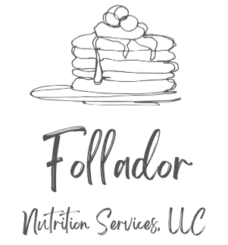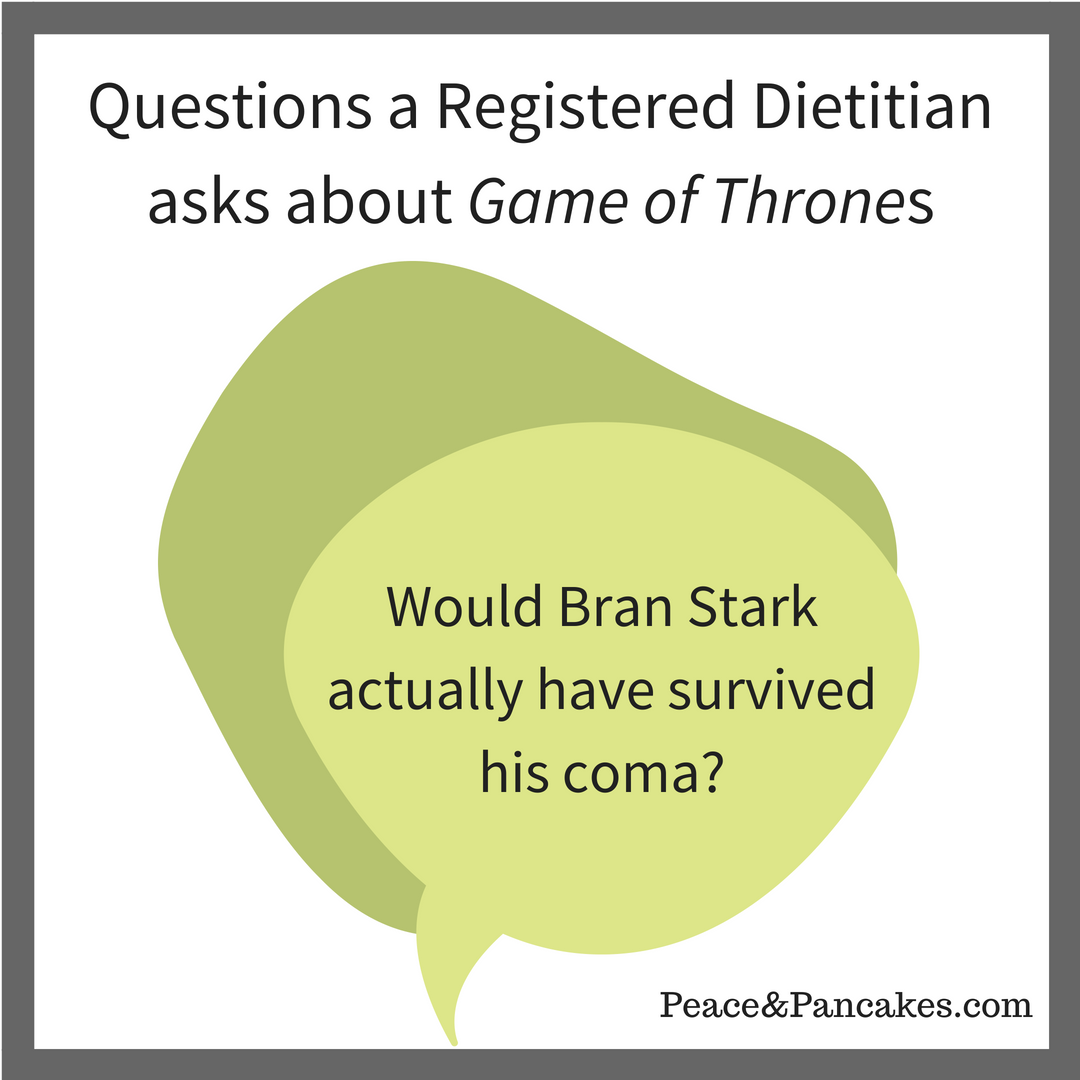While studying for my registered dietitian exam last summer, I was also catching up on Game of Thrones – a combo that had me asking a lot of nutritional science questions regarding the middle ages.
My first stems from the very beginning of the series. At the end of the pilot episode, Bran Stark discovers one of Jaime Lannister’s dirty secrets. To protect his reputation, Jaime pushes Bran off of the top of a tower. Bran then falls into a coma and wakes up about a month later.
In today’s world, people in a coma are fed via a feeding tube or IV, neither of which were supplied to Bran during his coma. This made me wonder:
Would Bran Stark actually have survived his coma without food or water?
SPOILER ALERT: Bran did indeed survive, so I dug through my undergraduate notes and took a closer look at my four main concerns: dysphagia, hydration status, nutrition status, and refeeding syndrome.
Concern #1: Dysphagia
While it’s not shown in the show, it is apparently mentioned in the novel that Maester Lewin fed Bran water and honey during his coma.
…I’m skeptical.
People in a coma often lack swallowing and/or gag reflexes, which can result in dysphagia (aka swallowing difficulty). This makes consuming food and fluid orally unsafe due to the risk for aspiration (when food or fluid goes into the lungs instead of the esophagus). To prevent aspiration, coma patients today’s world are often fed via a feeding tube or IV.
Some patients in a coma can still open their eyes, swallow, and respond to stimuli, making the idea that Bran was fed water and honey not ENTIRELY out of the question.
…I still find it unrealistic (aspiration pneumonia, anyone?)
Concern #2: Hydration Status
Water is essential for survival. It serves as a medium for cellular processes, carries oxygen and nutrients to cells, transports wastes to the liver and kidneys for excretion, and regulates body temperature via sweat production. To carry out these vital functions, the water lost via urine, feces, sweat, and exhalation must be replaced by either drinking fluids or via feeding tube or IV. (Read more about hydration here.)
The maximum amount of time a healthy adult can survive without water intake is about 10 days, and a child can last about 5 days. Survival time is increased in cooler environments with little fluid output.
Since Bran is sedentary and doesn’t have excessive output, his fluid needs are probably pretty baseline. Based on the Daily Recommended Intake (DRI), his needs range from 1.7 L/day (4 to 8-year-olds) to 2.4 L/day (9 to 13-year-olds). Getting roughly this fluid amount (about eight 8-ounce glasses) would have been difficult, so it’s safe to say he would have at least been dehydrated.
If he could not safely swallow, he most certainly would not have survived. However, other Game of Thrones characters have become zombies or been resurrected via the “Lord of Light,” so Bran’s survival with minimal fluid isn’t a completely crazy assumption.
Concern #3: Nutrition Status
It’s assumed that humans can last about 1-3 months without food if they have adequate hydration. The variation in survival time mainly stems from body stores: more body fat and muscle tissue = longer survival. Human studies on complete starvation (aka no food, only hydration) are hard to come by due to ethical reasons. Nonetheless, those that do exist haven’t gone beyond 40 days and include:
- A monk fasting for religious reasons: 36 days
- A group of four adults: one stopped fasting at 38 days, and the others stopped at 40 days
- 33 South African political prisoners: 28 days
- The longest Ghandi ever fasted: 21 days
While the body definitely doesn’t like it, as it goes longer without food, it adapts to survive. These stages of adaptation are important to review in order to assess Bran’s survival chances.
Initially after eating, the body digests and utilizes food for energy and stores anything it does not use. An increase in insulin promotes the usage of glucose as energy and storage fatty acids as triglycerides.
About 2-6 hours without food, insulin decreases & glucagon increases. This hormonal shift inhibits the storage of fat and glucose, promotes the breakdown of glycogen to glucose, and increases the process of gluconeogenesis. Gluconeogenesis is just a fancy way to say that the body cells (mainly liver cells) take other molecules, like amino acids, and turn them into glucose. The body prefers to use protein for this process: about 58% of protein (mainly alanine) can be converted to glucose, while only 10% of fat (the glycerol) can be converted to glucose.
If the body goes 18-48 hours without food, it’s time to hop on the struggle bus. Liver glycogen (the body’s main source of glucose during food deprivation) becomes completely depleted. Glucagon and glucocorticosteroid hormones increase, thus promoting the usage of body protein for gluconeogenesis. Most tissues, like the muscle and liver, increase the usage of fatty acids for energy, thus preserving glucose for the brain and red blood cells.
When starvation prolongs beyond 48 hours, most body cells switch to using primarily fat (and to a lesser extent protein) for energy. This serves two purposes: to preserve 1) amino acids for their other essential functions and 2) glucose for cells that need it most (brain & red blood cells). Gluconeogenesis continues mainly in the liver and to a smaller extent in the kidneys.
Where it gets really serious: Fatty acids cannot cross the blood-brain barrier, so the brain is in big trouble. The liver comes in to save the day by converting some fatty acids to ketone bodies, which can pass the blood-brain barrier. In addition to the brain, the heart and red blood cells also use ketone bodies.
If a person survives without food intake beyond 2 weeks, their remaining time is extremely limited. Once adipose stores are mostly depleted, the catabolization of body proteins increases, leading to the depletion of both muscle protein and organ tissue and eventually death.
So, now that we’ve reviewed the starvation response – would Bran have survived?
Without water: no. As stated previously, humans can only last an estimated 5-10 days without water.
Without food but with water: Maybe, but highly unlikely. Bran doesn’t appear to have large fat or muscle stores so a month without food could lead to a quick breakdown of organ tissue.
With sips of honey and water: Maybe, but still highly unlikely. I estimated Bran’s energy needs to range from 1078-2240 calories per day. Getting this amount of energy solely from sips of honey would be difficult, but it would help to prolong survival by providing some glucose. Sips of water would also increase his survival chances, but once again would be inadequate to meet his needs.
What about micronutrients?
Whether or not Bran was getting some calories from honey, he definitely would have been deficient in vitamins and minerals. Case closed.
Concern #4: Refeeding Syndrome
Refeeding syndrome occurs when a malnourished person is fed too aggressively, leading to undesirable outcomes such as confusion, seizures, coma, fluid overload, respiratory failure, and cardiac arrhythmias/cardiac failure. What causes this? After feeding, the insulin that is released by the pancreas induces a shift of potassium, magnesium, and phosphorus into body cells to allow for metabolism. Even if blood levels appear within normal limits, they drop drastically as these electrolytes and divalents shift into cells.
Additionally, malnourished patients are often deficient in thiamin, which is a vitamin that is needed for carbohydrate metabolism. Since the brain primarily uses glucose for energy, thiamin deficiency can prevent brain cells from utilizing energy from carbohydrates, thus resulting in brain cell death. Wernicke encephalopathy, characterized by coma, seizures, and convulsions, can result.
In today’s world, malnourished patients are usually re-fed with extreme caution to prevent refeeding syndrome, and extra potassium, magnesium, phosphorus, and thiamin are administered prior to and during feeding.
Bran would have most certainly been at risk for refeeding syndrome. Since people in medieval times were not aware of this, he could have been fed too aggressively and thus experienced cardiac & respiratory abnormalities, as well as seizures, another coma, or death.
The Takeaway
Bran’s survival chances are pretty slim. I’m thankful to live in a world with feeding tubes, IVs, and dietitians that know how to keep coma patients properly nourished!
Sources
- Mahan, L. Kathleen, and Janice L. Raymond. Krause’s Food & the Nutrition Care Process. N.p.: n.p., 2017. Print.
- Gropper S, Smith J, Groff J. Advanced Nutrition and Human Metabolism. 6th ed. Belmont, CA: Thomson Wadsworth; 2009.
- Keys A, Brozek J, Henshel A, Mickelsen O, Longstreet Taylor H. The biology of human starvation. Minneapolis: University of Minnesota Press, 1950.

